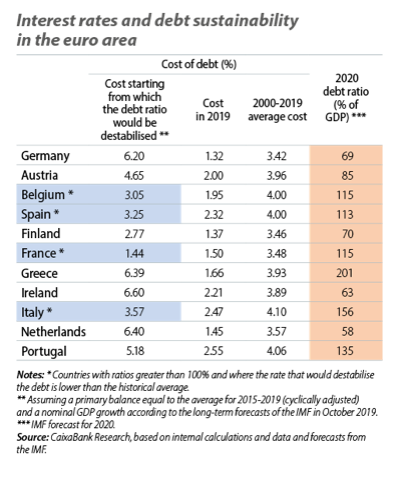Adrià Morrón Salmerón (Caixabank Research) | The COVID-19 pandemic has forced economic activity to be suspended. This paralysis, together with the imperative to protect workers and businesses with a decisive fiscal policy response, will result in a significant increase in public debt among the major economies of the euro area (as shown in the IMF’s own estimates, which we reproduce in the first chart). Furthermore, in the absence of a more ambitious EU fiscal policy, the projections suggest that the increase in debt will be much greater in countries where the public sector already had a high level of indebtedness beforehand. In the financial markets, this situation has raised concerns over public debt sustainability and these doubts have been reflected both in the rise in sovereign risk premiums (described in the financial markets economic outlook section of this same Monthly Report) and in the expectation – implicit in financial security prices – of potential credit rating downgrades (see second chart), especially before the ECB announced its support package to combat the COVID-19 crisis in March.


Does the COVID-19 crisis compromise the sustainability of the public finances?
The sustainability of public debt depends on four elements: the initial level of debt, the fiscal balance (surplus or deficit), the interest payments generated by the debt and the growth of the economy. One of the key relationships between these four factors is the one between growth and the interest rate. Starting from an initial level of debt, GDP growth reduces the burden which that debt represents relative to the total resources in the economy, while interest charges raise the total amount to be repaid: thus, the greater the economic growth relative to the interest rate, the easier it will be to reduce the debt burden. In this regard, the ECB’s monetary policy has anchored an environment of sufficiently low interest rates so as not to compromise the sustainability of the debt. However, in order for this to happen, not only will it be important that the ECB maintains an environment of low rates, but also that the COVID-19 crisis does not cause lasting damage to economic growth. In other words, it is vital that there is a decisive and coordinated economic policy response that allows a rapid economic recovery and, as a result, growth in economic activity well above that of interest charges.
In the future, is it feasible to achieve a level of fiscal discipline that neither compromises growth nor puts the sustainability of debt at risk?
Despite allaying fears in the short term, the fact that both the ECB and future growth will have a key role to play in determining the sustainability of debt suggests that the outlook for the most heavily indebted economies of the euro area is somewhat fragile. When the recovery is set in motion, the first challenge will lie in defining a fiscal policy which helps to boost the economy. In a second phase, the challenge will be to ensure that fiscal policy becomes more disciplined but without smothering growth. When we analyse the available margin for manoeuvre, it is clear that this will not be an easy task – but not an impossible one either.
One of the limits of this path is defined by the primary fiscal balance (i.e. excluding interest payments) that enables us to keep the debt ratio stable at its levels projected for 2020. At the other end of the spectrum, the limit is set by the balance that would reduce debt down to 60% in 20 years. As shown in the third figure, in which we present these two limits, both the expectation of GDP growth returning to normal and the ECB’s support in the form of low interest rates provide a good safety buffer: all the major economies of the euro area could reduce the public debt ratio with an even more expansive fiscal policy than that implemented in 2015-2019. However, reducing it significantly is quite another matter: Italy, France and Spain would need significantly more positive primary balances than those registered in recent years, and Portugal would have to be at least as disciplined as it was in 2015-2019.

Would a tightening of risk premiums compromise the sustainability of debt?
The above findings depend on two important assumptions: (i) a return to sustained nominal GDP growth in the coming years, and (ii) the interest rate environment remaining favourable. Therefore, a tightening of financial conditions and the consequent increase in the cost of debt could jeopardise governments’ room for manoeuvre. How fragile is each economy in the face of this change in the environment? To answer this question, in the fourth figure we present an estimate of the interest rate threshold starting from which a sustained increase in the debt ratio would be triggered (assuming a primary fiscal balance equal to the average for 2015-2019 and a nominal GDP growth equal to each country’s potential). Compared with the current interest cost, virtually all countries appear to have a certain capacity to withstand higher interest rates (the exception is France, which in our estimates is penalised for having maintained a primary fiscal balance of around –2% on average in 2015-2019). In the case of Italy, Belgium and Spain, the interest rates that would put pressure on their levels of debt exceeds current levels by more than 1 pp.

Should we be concerned?
Our analysis suggests that the sustainability of public debt is not in question. However, it also shows that the environment is highly demanding and places the ECB in a key position. But achieving a sustained recovery in economic activity will be just as key, and this requires a coordinated response from economic policy.





